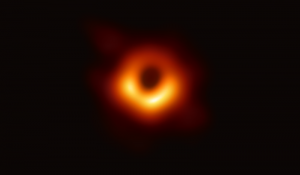The astrophysicist who led the team that took the first picture of a black hole will speak at The University of Toledo this month.
The free, public event is the first in the UToledo Department of Physics and Astronomy’s Excellence in Astronomy series focusing on astronomers who through their vision, persistence and teamwork have made extraordinary leaps in our understanding of the universe.

Dr. Shep Doeleman, a Smithsonian astrophysicist, Harvard senior research fellow and founding director of the Event Horizon Telescope
Dr. Shep Doeleman, a Smithsonian astrophysicist, Harvard senior research fellow and founding director of the Event Horizon Telescope, will give his lecture titled “How to Take a Photo of a Black Hole” 7 p.m. Thursday, April 27, in Rocket Hall Room 1520.
“Twenty years ago, Dr. Doeleman and I both worked at Massachusetts Institute of Technology’s Haystack Observatory,” said Tom Megeath, Distinguished University Professor of Astronomy at UToledo. “He was working on a project that I thought was far-fetched—unlikely to pay off in a big way. Twenty years later, persistence, ingenuity and the management of a global team paid off.”
On April 10, 2019, the Event Horizon Telescope made the first image of a black hole.
That visual of a ring of emission around a black hole at the heart of galaxy M87, located 55 million light years away, confirmed Albert Einstein’s theory of general relativity at the boundary of black hole — showing how gravity bends the fabric of space and time.
Three years later, the telescope spotted a similar structure surrounding a black hole at the center of our Milky Way galaxy.
Their pictures are some of the most downloaded science images in the world.

Using the Event Horizon Telescope, scientists obtained an image of the black hole at the center of galaxy M87, outlined by emission from hot gas swirling around it under the influence of strong gravity near its event horizon. Credit: Event Horizon Telescope collaboration.
“Black holes are cosmic objects so small and dense, that nothing, not even light can escape their gravitational pull,” Doeleman said. “Until recently, no one had ever seen what a black hole actually looked like. Einstein’s theories predicted that a distant observer should see a ring of light encircling the black hole, which forms when radiation emitted by infalling hot gas is lensed by the extreme gravity near the event horizon.”
The Event Horizon Telescope is a global array of radio dishes, linked together by a network of atomic clocks to form an Earth-sized virtual telescope that can resolve the nearest supermassive black holes where this ring feature may be measured.
Doeleman’s talk will cover how this was accomplished, the impact and what the future holds for the study of black holes.